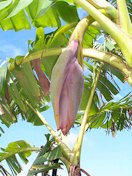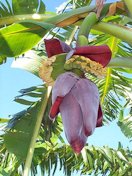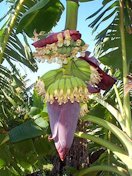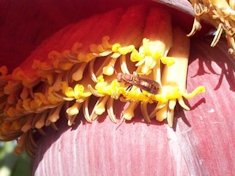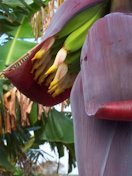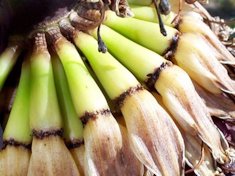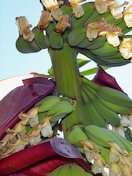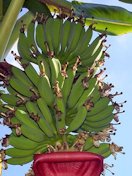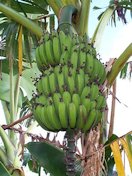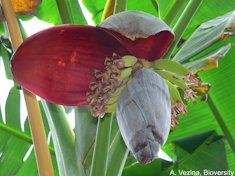Banana Inflorescence Series "The series of banana images below were taken over 1 year ago here at the Tropical Research and Education Center. My technique was to mark a series of pseudostems within our 2 acre collection and photograph them every two days. The fast pace growth of the banana during the hot wet summer days appeared to occur almost hourly as the plant makes noticeably rapid transitions through its flowering period." Ian Maguire, 2000 'FHIA 02' Banana
The inflorescence is a complex structure that includes the flowers that will develop into fruits. It is supported by the aerial true stem, which is often called the floral stem. The aerial true stem is produced by the terminal growing point on the rhizome. It grows through the pseudostem and emerges at the top of the plant soon after the last cigar leaf. 1
Fig. 13 . The inflorescence emerges at the top of the plant and soon starts pointing down, with the exception of Fei bananas The female (pistillate) flowers appear first. In cultivated bananas, the ovary develops into a seedless fruit by parthenocarpy (without being pollinated). As it lifts, the bract (a modified leaf associated with a reproductive structure, such as a flower) exposes a cluster of female flowers that are normally arranged in two rows. These flowers will develop into a hand of fruit. The number of hands in the bunch depends on the number of female clusters in the inflorescence, and varies depending on the genotype and environmental conditions. 1
Fig. 14 . The bract lifts, or curls up at the tip, exposing the female flowers that will develop into fruit. The flowers are arranged in clusters, the future hands. As the female flowers develop into fruit, the distal portion of the inflorescence elongates and produces clusters of male (staminate) flowers, each subtended by a bract. The male flowers in the male bud produce pollen that may or may not be sterile. A third type of flowers called hermaphrodite, or neutral, may be present on the stalk between the female flowers and the male bud, traditionally called the rachis, but which some scientists argue is part of the peduncle. They generally do not develop into fruit and their stamens do not produce pollen. 1
Fig. 15. Below the female flowers, some cultivars possess hermaphrodite flowers, also called neutral flowers Fig. 16. The last type of flowers to appear are the male flowers, which are also subtended by a bract Peduncle In botany, the peduncle is the stalk that supports the inflorescence. Yet, in the Descriptors for bananas, the peduncle refers only to the stalk between the leaf crown and the first hand of fruit, whereas the stalk that actually supports the female and male flowers is called rachis. Australian scientists argue that in keeping with the botanical definition of the term, the peduncle starts at the first visible node and ends at the meristem in the male bud. For what is traditionally called peduncle, they propose transitional peduncle because it supports organs that are in transition from leaves to bracts. They propose female peduncle for the section that supports the female flowers that become fruits, and male peduncle for the section that supports the nodes of male flowers, the traditional rachis. 1 Bunch The bunch is the descriptive term that includes all the fruits. The fruits are arranged into hands, the former clusters of flowers that were each subtended by a bract. By analogy, the fruits in a hand are often called fingers. The largest bunch, according to Guinness World Records, weighed in at 130 kg. 1 Rachis The rachis traditionally refers to the part between the male bud and the last hand of fruit, or the first one depending on the author, but Australian scientists argue that it is the continuation of the peduncle, obviating the need for the ambiguous term rachis, which in botany has also been used for vegetative structures. The part below the last hand (which they call the male peduncle can be bare or covered with persistent bracts. The scars indicate where the bracts were attached. They are called nodes. 1 Male Bud The male bud contains the male flowers enclosed in their bracts. It is sometimes called the bell. As the fruits mature, the rachis (or male peduncle and male bud) continue to grow. In some cultivars, the male bud ceases to grow after the fruits have set and can be more or less exhausted by the time the bunch reaches maturity. The presence or absence of the male bud is one of the traits used to distinguish cultivars. 1 Back to Banana Page Varieties Page |
||||||||||||||||||||||||||||||||
| Bibliography 1 Vézina, Anne, et al. "Morphology of the banana plant." Musapedia, the banana knowledge compedium, 4 Oct. 2017, (CC BY-NC-SA 3.0), www.promusa.org/Morphology+of+banana+plant. Accessed 23 Apr. 2018. Photographs Fig. 1,2,3,4,5,6,7,8,9,10,11,12 Maguire, Ian. "Banana Inflorescense Series." Tropical Fruit Photography Picture Archive, 2000, trec.ifas.ufl.edu. Accessed 24 Mar. 2014. Fig. 13 Vezina, Annem "The emerging inflorescence contains the flowers that will become fruits." Bioversity International, Musapedia, the banana knowledge compedium, July 2010, (CC BY-NC-SA 4.0), www.musarama.org/en/image/emerging-inflorescence-75.html. Accessed 23 Apr. 2018. Fig. 14 Vezina, A.. "The opened bracts reveal female flowers arranged in clusters. Cultivated bananas being parthenocarpic, the female flowers develop into edible fruits without pollination." Bioversity International, Musapedia, the banana knowledge compedium, Aug. 2009, (CC BY-NC-SA 4.0), www.musarama.org/en/image/developing-female-flowers-76.html. Accessed 23 Apr. 2018. Fig. 15 Vezina, A. "Certain cultivars possess clusters of flowers of transitional nature that are positioned between the female flowers, which turn into fruit, and the male flowers, which produce the pollen." Bioversity International, Musapedia, the banana knowledge compedium, July 2010, (CC BY-NC-SA 4.0), www.musarama.org/en/image/intermediate-flowers-77.html. Accessed 23 Apr. 2018. Fig. 16 "The last type of flowers to appear are the male flowers, which are also subtended by a bract." Musapedia, the banana knowledge compedium, (CC BY-NC-SA 4.0), www.promusa.org/Morphology+of+banana+plant. Accessed 23 Apr. 2018. Published 24 Mar. 2014 LR. Last update 23 Apr. 2018 LR |
||||||||||||||||||||||||||||||||
